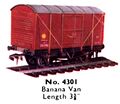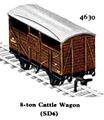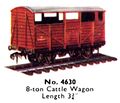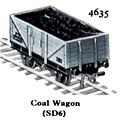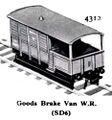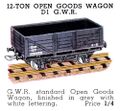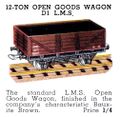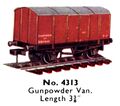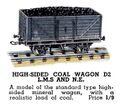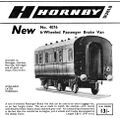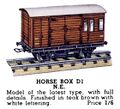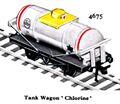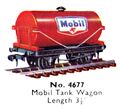Category:Hornby Dublo rolling stock: Difference between revisions
(+pictures) |
(+some text. needs more) |
||
| Line 1: | Line 1: | ||
{{FH150}}{{Menu_Dublo}} | {{FH150}}{{Menu_Dublo}} | ||
{{Box|Petrol_Tank_Wagon_'ESSO',_Hornby_Dublo_D1_(HBoT_1939).jpg|1939 | {{Box|Petrol_Tank_Wagon_'ESSO',_Hornby_Dublo_D1_(HBoT_1939).jpg|1939: All-metal construction – metal base, metal ends, litographed tinplate tank body, painted cast metal filler-cap.|280}} | ||
{{Box|Tank_Wagon_Shell_D1_Hornby_Dublo_4678_(HDBoT_1959).jpg|1959|280}} | {{Box|Tank_Wagon_Shell_D1_Hornby_Dublo_4678_(HDBoT_1959).jpg|1959|280}} | ||
{{Box|United_Dairies_Milk_Tank_Wagon_(six-wheeled),_Hornby-Dublo_4657_(DubloCat_1963).jpg|1963: The milk tank wagon now has a moulded plastic tank|280}} | |||
{{Box|Hornby_Dublo_couplings_(HDBoT_1959).jpg|1959: Dublo couplings|280}} | {{Box|Hornby_Dublo_couplings_(HDBoT_1959).jpg|1959: Dublo couplings|280}} | ||
{{Box|Hornby_Dublo_4076_6-wheeled_Passenger_Brake_Van_(MM_1963-10).jpg|1963|280}} | {{Box|Hornby_Dublo_4076_6-wheeled_Passenger_Brake_Van_(MM_1963-10).jpg|1963|280}} | ||
==The transition from metal to plastics== | |||
The '''[[Hornby Dublo]] rolling-stock''' was initially all-metal, with diecast bogies and frames, and tinplate carriage superstructure. After [[World War Two] plastic detailing started creeping in, carriages still had metal bases and sides, but plastic ends, and plastic started appearing in minor detailing such as tank caps. | |||
{{BigPic|Hornby_Dublo_Super_Detail_(MM_1960-04).jpg|1960 ad for "Super-Detail" rolling stock}} | |||
[[Meccano Ltd]]. finally embraced plastic mouldings with the launch of their "Super Detail" (SD6) pieces, which had moulded superstructure. The first SD6 pieces had exaggerated protruding detail, but the company soon began to use the new technology to produce genuinely new designs that worked better in plastic than metal, rather than just producing plastic versions of their initial metal range. The new plastics allowed realistically complex shapes for hopper wagons and for heavy-duty reinforced wagons with external struts. | |||
{{BigPic|Hornby_Dublo_SD6_Super_Detail_rolling_stock_(MM_1958-10).jpg|1958: Some plastic "super-detail" rolling stock}} | |||
{{Dublo}} | {{Dublo}} | ||
Revision as of 01:50, 16 February 2015
Dublo : Hornby Dublo | Dublo 1938 | Dublo sets | Dublo locos | Dublo rolling stock | Dublo accessories | Dublo Dinky | (end) | Wrenn
1939: All-metal construction – metal base, metal ends, litographed tinplate tank body, painted cast metal filler-cap. [image info]
1959 [image info]
1963: The milk tank wagon now has a moulded plastic tank [image info]
1959: Dublo couplings [image info]
1963 [image info]
The transition from metal to plastics
The Hornby Dublo rolling-stock was initially all-metal, with diecast bogies and frames, and tinplate carriage superstructure. After [[World War Two] plastic detailing started creeping in, carriages still had metal bases and sides, but plastic ends, and plastic started appearing in minor detailing such as tank caps.
Meccano Ltd. finally embraced plastic mouldings with the launch of their "Super Detail" (SD6) pieces, which had moulded superstructure. The first SD6 pieces had exaggerated protruding detail, but the company soon began to use the new technology to produce genuinely new designs that worked better in plastic than metal, rather than just producing plastic versions of their initial metal range. The new plastics allowed realistically complex shapes for hopper wagons and for heavy-duty reinforced wagons with external struts.
Subcategories
This category has only the following subcategory.
H
- Hornby Dublo Low-sided Wagons (4 P, 9 F)
Pages in category ‘Hornby Dublo rolling stock’
The following 46 pages are in this category, out of 46 total.
B
C
- Canadian Pacific Caboose 437270 (Hornby Dublo)
- Cattle Truck 8-ton GWR 106324 (Hornby Dublo D1)
- Cattle Truck GWR 106324 (Hornby Dublo D1)
- Cattle Wagon 8-Ton B893344 SD6 (Hornby Dublo 4630)
- Coal Wagon LMS 210112 (Hornby Dublo D1)
- Coal Wagon LNER 404844 (Hornby Dublo D1)
- Corridor Coach WR First-Second Class, W15870 (Hornby Dublo 4050)
- Corridor Coach, 1st-3rd teak, LNER 42759 (Hornby Dublo D1)
G
H
L
M
R
S
T
Media in category ‘Hornby Dublo rolling stock’
The following 160 files are in this category, out of 160 total.
- Banana Van, Hornby-Dublo 4301 (DubloCat 1963).jpg 818 × 709; 102 KB
- Blue Spot Fish Van, ER, Hornby Dublo 4300 (DubloCat 1963).jpg 842 × 671; 107 KB
- Bogie Bolster Wagon D1, Hornby Dublo 4610 (HDBoT 1959).jpg 1,623 × 1,010; 197 KB
- Bogie Bolster Wagon, Hornby Dublo 4610 (DubloCat 1963).jpg 1,180 × 588; 99 KB
- Bogie Well Wagon 40-Ton D1, Hornby Dublo 4605 (HDBoT 1959).jpg 1,554 × 923; 180 KB
- Bogie Well Wagon 40-ton, Hornby Dublo 4605 (DubloCat 1963).jpg 1,197 × 525; 84 KB
- Breakdown Crane No133, Hornby Dublo 4620, profile.jpg 1,637 × 411; 129 KB
- Breakdown Crane No133, Hornby-Dublo 4620 (DubloCat 1963).jpg 2,358 × 1,222; 259 KB
- Breakdown Train Set, box artwork (Hornby Dublo 2049).jpg 2,000 × 1,781; 325 KB
- Bulk Grain Wagon 20-Ton SD6, Hornby Dublo 4625 (HDBoT 1959).jpg 1,065 × 1,169; 203 KB
- Bulk Grain Wagon 20-ton, Hornby Dublo 4625 (DubloCat 1963).jpg 881 × 753; 114 KB
- Cattle Truck GWR, Hornby Dublo D1 (HBoT 1939).jpg 560 × 526; 80 KB
- Cattle Truck LMS, Hornby Dublo D1 (HBoT 1939).jpg 555 × 489; 77 KB
- Cattle Wagon 8-Ton SD6, Hornby Dublo 4630 (HDBoT 1959).jpg 937 × 1,077; 151 KB
- Cattle Wagon 8-ton, Hornby-Dublo 4630 (DubloCat 1963).jpg 847 × 730; 108 KB
- Coal Wagon SD6, Hornby Dublo 4635 (HDBoT 1959).jpg 813 × 811; 104 KB
- Coal Wagon, Hornby Dublo D1 (HBoT 1939).jpg 1,144 × 940; 177 KB
- Coal Wagon. Hornby Dublo 4635 (DubloCat 1963).jpg 767 × 603; 81 KB
- Composite Sleeping Car, BR, Hornby-Dublo 4078 (DubloCat 1963).jpg 1,689 × 701; 213 KB
- Corridor Coach 1st 2nd, BR, Hornby Dublo 4052 (DubloCat 1963).jpg 1,669 × 756; 213 KB
- Corridor Coach 1st 2nd, SR, Hornby Dublo 4054 (DubloCat 1963).jpg 1,662 × 771; 220 KB
- Corridor Coach 1st-2nd D22, Hornby Dublo 4013 (HDBoT 1959).jpg 1,750 × 892; 226 KB
- Corridor Coach BR 1st-2nd D12, Hornby Dublo 4005 (HDBoT 1959).jpg 1,893 × 913; 239 KB
- Corridor Coach BR Brake-2nd D12, Hornby Dublo 4006 (HDBoT 1959).jpg 1,632 × 845; 217 KB
- Corridor Coach Brake-2nd D22, Hornby Dublo 4014 (HDBoT 1959).jpg 1,887 × 955; 266 KB
- Corridor Coach Brake-2nd WR, Hornby Dublo 4051 (DubloCat 1963).jpg 1,629 × 778; 210 KB
- Corridor Coach Brake-Second BR, Hornby Dublo 4053 (MM 1960-012).jpg 1,885 × 980; 229 KB
- Corridor Coach Brake-Second WR, Hornby Dublo 4051 (MM 1960-012).jpg 1,878 × 971; 219 KB
- Corridor Coach Brake-Third LMS, Hornby Dublo D3 (HBoT 1939).jpg 934 × 479; 115 KB
- Corridor Coach First-Second BR, Hornby Dublo 4052 (MM 1960-012).jpg 1,932 × 1,009; 238 KB
- Corridor Coach First-Second WR, Hornby Dublo 4050 (MM 1960-012).jpg 1,770 × 967; 202 KB
- Corridor Coach First-Third LMS, Hornby Dublo D3 (HBoT 1939).jpg 1,039 × 482; 146 KB
- Corridor Coach LNER, Hornby Dublo D1 (1938 Dublo brochure).jpg 801 × 387; 77 KB
- Corridor Coach LNER, Hornby Dublo D1 (HBoT 1939).jpg 887 × 466; 101 KB
- Corridor Coach WR 1st-2nd D21, Hornby Dublo 4009 (HDBoT 1959).jpg 1,911 × 967; 264 KB
- Corridor Coach WR Brake-2nd D21, Hornby Dublo 4010 (HDBoT 1959).jpg 1,649 × 887; 218 KB
- Double Bolster Wagon with Timber Load, Hornby Dublo 4615 (DubloCat 1963).jpg 1,003 × 598; 103 KB
- Double Bolster Wagon with Timber Load, Hornby Dublo 4615 (HDBoT 1959).jpg 1,208 × 1,036; 160 KB
- Esso Fuel Oil Tank Wagon, Hornby Dublo 4680 (DubloCat 1963).jpg 728 × 692; 92 KB
- Esso Tank Wagon, Hornby Dublo 4676 (DubloCat 1963).jpg 828 × 686; 95 KB
- Fish Van NE, Hornby Dublo D1 (HBoT 1939).jpg 569 × 519; 81 KB
- Fruit Van WR, Hornby Dublo 4305 (HDBoT 1959).jpg 1,524 × 1,324; 260 KB
- Goods Brake Van BR SD6, Hornby Dublo 4311 (HDBoT 1959).jpg 969 × 997; 145 KB
- Goods Brake Van GW, Hornby Dublo D1 (DubloBrochure 1938).jpg 545 × 505; 81 KB
- Goods Brake Van GW, Hornby Dublo D1 (HBoT 1939).jpg 569 × 512; 76 KB
- Goods Brake Van LMR SD6, Hornby Dublo 4310 (HDBoT 1959).jpg 929 × 955; 144 KB
- Goods Brake Van LMS, Hornby Dublo D1 (DubloBrochure 1938).jpg 536 × 499; 80 KB
- Goods Brake Van LMS, Hornby Dublo D1 (HBoT 1939).jpg 575 × 519; 73 KB
- Goods Brake Van LNER, Hornby Dublo D1 (DubloBrochure 1938).jpg 537 × 515; 70 KB
- Goods Brake Van LNER, Hornby Dublo D1 (HBoT 1939).jpg 583 × 503; 69 KB
- Goods Brake Van SR, Hornby Dublo D1 (DubloBrochure 1938).jpg 531 × 503; 73 KB
- Goods Brake Van SR, Hornby Dublo D1 (HBoT 1939).jpg 552 × 492; 74 KB
- Goods Brake Van WR SD6, Hornby Dublo 4312 (HDBoT 1959).jpg 933 × 998; 146 KB
- Goods Brake Van, BR, Hornby Dublo 4311 (DubloCat 1963).jpg 849 × 721; 96 KB
- Goods Brake Van, LMR, Hornby Dublo 4310 (DubloCat 1963).jpg 884 × 678; 109 KB
- Goods Brake Van, WR, Hornby-Dublo 4312 (DubloCat 1963).jpg 891 × 737; 105 KB
- Goods Van 12-Ton GWR, Hornby Dublo D1 (DubloBrochure 1938).jpg 503 × 503; 74 KB
- Goods Van 12-Ton GWR, Hornby Dublo D1 (HBoT 1939).jpg 576 × 516; 57 KB
- Goods Van 12-Ton LMS, Hornby Dublo D1 (DubloBrochure 1938).jpg 499 × 483; 73 KB
- Goods Van 12-Ton LMS, Hornby Dublo D1 (HBoT 1939).jpg 562 × 498; 72 KB
- Goods Van 12-Ton LNER, Hornby Dublo D1 (DubloBrochure 1938).jpg 507 × 545; 81 KB
- Goods Van 12-Ton LNER, Hornby Dublo D1 (HBoT 1939).jpg 571 × 533; 70 KB
- Goods Van 12-Ton SR, Hornby Dublo D1 (DubloBrochure 1938).jpg 489 × 511; 70 KB
- Goods Van 12-Ton SR, Hornby Dublo D1 (HBoT 1939).jpg 561 × 508; 52 KB
- Goods Wagon Open 12-Ton SR, Hornby Dublo D1 (DubloBrochure 1938).jpg 503 × 489; 72 KB
- Goods Wagon Steel type SD6, Hornby Dublo 4640 (HDBoT 1959).jpg 951 × 923; 143 KB
- Goods Wagon, Steel Type, Hornby Dublo 4640 (DubloCat 1963).jpg 801 × 596; 82 KB
- Gunpowder Van, Hornby-Dublo 4313 (DubloCat 1963).jpg 758 × 668; 88 KB
- High-Capacity Wagon, Hornby Dublo D1 (HBoT 1939).jpg 878 × 464; 104 KB
- High-Sided Coal Wagon, Hornby Dublo D2 (HBoT 1939).jpg 1,144 × 1,004; 212 KB
- High-Sided Wagon LMS, Hornby Dublo D2 (HBoT 1939).jpg 577 × 511; 80 KB
- High-Sided Wagon LNER, Hornby Dublo D2 (HBoT 1939).jpg 570 × 467; 70 KB
- Hopper Wagon 21-ton, Hornby Dublo 4644 (DubloCat 1963).jpg 830 × 664; 101 KB
- Hornby Dublo 4076 6-wheeled Passenger Brake Van (MM 1963-10).jpg 970 × 950; 156 KB
- Hornby Dublo 4644 21-Ton Hopper Wagon (MM 1963-10).jpg 1,068 × 658; 96 KB
- Hornby Dublo Goods Brake Van SD6, LT25 (MM 1958-09).jpg 1,589 × 2,213; 628 KB
- Hornby Dublo SD6 Super Detail rolling stock (MM 1958-10).jpg 2,941 × 2,241; 755 KB
- Hornby Dublo Super Detail (MM 1960-04).jpg 2,799 × 946; 146 KB
- Horse Box BR, Hornby Dublo Super Detail 4315 (MM 1960-04).jpg 1,684 × 1,088; 260 KB
- Horse Box NE, Hornby Dublo D1 (HBoT 1939).jpg 558 × 507; 81 KB
- Horse Box SR, Hornby Dublo Super Detail 4316 (MM 1960-04).jpg 1,734 × 1,103; 260 KB
- Horse Box with Horse BR, Hornby Dublo 4315 (HDBoT 1959).jpg 1,305 × 1,179; 193 KB
- Horse Box with Horse SR, Hornby Dublo 4316 (HDBoT 1959).jpg 1,395 × 1,270; 232 KB
- Horse Box with Horse, BR, Hornby Dublo 4315 (DubloCat 1963).jpg 997 × 728; 118 KB
- Horse Box with Horse, SR, Hornby Dublo 4316 (DubloCat 1963).jpg 997 × 756; 129 KB
- ICI Bulk Salt Wagon 20-ton, Hornby Dublo 4627 (DubloCat 1963).jpg 785 × 650; 84 KB
- ICI Caustic Liquor Bogie Wagon, Hornby-Dublo 4685 (DubloCat 1963).jpg 1,039 × 718; 127 KB
- ICI Chlorine Tank Wagon, Hornby Dublo 4675 (DubloCat 1963).jpg 812 × 737; 100 KB
- ICI Chlorine Tank Wagon, Hornby Dublo 4675 (HDBoT 1959).jpg 1,193 × 1,033; 194 KB
- Low-sided Wagon D1, Hornby Dublo 4645 (HDBoT 1959).jpg 1,050 × 814; 127 KB
- Low-sided Wagon with Cable Drums D1, Hornby Dublo 4646 (HDBoT 1959).jpg 1,172 × 1,064; 197 KB
- Low-sided Wagon with Cable Drums, Hornby Dublo 4646 (DubloCat 1963).jpg 987 × 721; 110 KB
- Low-sided Wagon with Furniture Container D1, Hornby Dublo 4647 (HDBoT 1959).jpg 1,332 × 1,208; 247 KB
- Low-sided Wagon with Insulated Meat Container D1, Hornby Dublo 4648 (HDBoT 1959).jpg 1,403 × 1,315; 254 KB
- Low-sided Wagon with Tractor, Hornby Dublo 4649 (DubloCat 1963).jpg 862 × 630; 99 KB
- Low-sided Wagons, Hornby-Dublo (MM 1954-05).jpg 1,113 × 1,600; 434 KB
- Machine Wagon, Lowmac, Hornby Dublo 4652 (DubloCat 1963).jpg 1,061 × 487; 73 KB
- Meat Van LMS, Hornby Dublo D1 (HBoT 1939).jpg 566 × 515; 84 KB
- Meat Van SR, Hornby Dublo D1 (HBoT 1939).jpg 557 × 523; 77 KB
- Mineral Wagon 16-Ton SD6, Hornby Dublo 4655 (HDBoT 1959).jpg 889 × 899; 147 KB
- Mineral wagon 16-ton, Hornby Dublo 4655 (DubloCat 1963).jpg 817 × 666; 94 KB
- Mineral Wagon 16-ton, Hornby-Dublo 4656 (DubloCat 1963).jpg 843 × 695; 95 KB
- Mobil Tank Wagon, Hornby Dublo 4677 (DubloCat 1963).jpg 771 × 693; 91 KB
- Oil Tank Wagon 'Royal Daylight', Hornby Dublo D1 (HBoT 1939).jpg 1,113 × 1,016; 187 KB
- Open Coach 1st Class, BR, Hornby Dublo 4062 (DubloCat 1963).jpg 1,591 × 742; 208 KB
- Open Coach 2nd Class, WR, Hornby Dublo 4061 (DubloCat 1963).JPG 1,592 × 757; 211 KB
- Open Goods Wagon 12-Ton GWR, Hornby Dublo D1 (HBoT 1939).jpg 567 × 473; 50 KB
- Open Goods Wagon 12-Ton LMS, Hornby Dublo D1 (HBoT 1939).jpg 571 × 494; 71 KB
- Open Goods Wagon 12-Ton LNER, Hornby Dublo D1 (HBoT 1939).jpg 577 × 491; 62 KB
- Open Goods Wagon 12-Ton SR, Hornby Dublo D1 (HBoT 1939).jpg 583 × 469; 72 KB
- Packing Van for Breakdown Crane, Hornby-Dublo 4318 (DubloCat 1963).jpg 949 × 750; 107 KB
- Passenger Brake Van, BR, Hornby-Dublo 4075 (DubloCat 1963).jpg 1,677 × 673; 210 KB
- Passenger Fruit Van, Hornby-Dublo 4305 (DubloCat 1963).jpg 975 × 694; 118 KB
- Petrol Tank Wagon 'ESSO', Hornby Dublo D1 (HBoT 1939).jpg 1,143 × 979; 189 KB
- Petrol Tank Wagon 'Power Ethyl', Hornby Dublo D1 (HBoT 1939).jpg 1,116 × 1,004; 192 KB
- Post Office TPO Mail Van Set, Hornby Dublo 3400 2400 D1 (HDBoT 1959).jpg 2,200 × 1,210; 443 KB
- Presflo Bulk Cement Wagon, BR, Hornby Dublo 4626 (DubloCat 1963).jpg 827 × 686; 82 KB
- Prestwyn Silo Wagon, Hornby-Dublo 4658 (DubloCat 1963).jpg 943 × 719; 111 KB
- Pullman Car 1st Class, Aries, Hornby Dublo 4035 (DubloCat 1963).jpg 1,661 × 653; 190 KB
- Pullman Car 2nd Class, Hornby Dublo 4036 (DubloCat 1963).jpg 1,675 × 683; 202 KB
- Pullman Car Brake-2nd Class, Hornby Dublo 4037 (DubloCat 1963).jpg 1,595 × 691; 201 KB
- Refrigerator Van 6-Ton WR1 SD6, Hornby Dublo 4320 (HDBoT 1959).jpg 921 × 1,093; 163 KB
- Refrigerator Van 6-ton, WR, Hornby Dublo 4320 (DubloCat 1963).jpg 856 × 735; 113 KB
- Restaurant Car Composite BR D20, Hornby Dublo 4048 (HDBoT 1959).jpg 1,741 × 909; 254 KB
- Restaurant Car Composite WR D20, Hornby Dublo 4047 (HDBoT 1959).jpg 1,815 × 939; 257 KB
- Restaurant Car E1939, corridor, Hornby Dublo 4071 (DubloCat 1963).jpg 1,881 × 1,276; 390 KB
- Restaurant Car W1910, corridor, Hornby Dublo 4070 (DubloCat 1963).jpg 1,865 × 1,288; 391 KB
- Saxa Salt Wagon SD6, Hornby Dublo 4665 (HDBoT 1959).jpg 1,039 × 1,085; 185 KB
- Saxa Salt Wagon, Hornby Dublo 4665 (DubloCat 1963).jpg 841 × 679; 103 KB
- Shell Tank Wagon, Hornby Dublo 4678 (DubloCat 1963).jpg 827 × 714; 98 KB
- Six-Wheeled Passenger Brake Van, BR, Hornby Dublo 4076 (DubloCat 1963).jpg 1,061 × 664; 122 KB
- SR Four-Wheeled Utility Van, Hornby Dublo 4323 (DubloCat 1963).jpg 1,067 × 714; 141 KB
- Standard Wagon 13-Ton SD6, Hornby Dublo 4670 (HDBoT 1959).jpg 852 × 853; 132 KB
- Standard Wagon 13-ton, Hornby Dublo 4670 (DubloCat 1963).jpg 783 × 617; 85 KB
- Suburban Coach 1st-2nd D14, Hornby Dublo 4021 (HDBoT 1959).jpg 1,570 × 854; 214 KB
- Suburban Coach 1st-2nd SR, Hornby Dublo 4025 (HDBoT 1959).jpg 1,711 × 932; 262 KB
- Suburban Coach Brake-2nd D14, Hornby Dublo 4022 (HDBoT 1959).jpg 1,744 × 944; 247 KB
- Suburban Coach Brake-2nd SR, Hornby Dublo 4026 (HDBoT 1959).jpg 1,592 × 859; 215 KB
- Suburban Coach, Brake 2nd, SR, Hornby Dublo 4082 (DubloCat 1963).JPG 1,610 × 709; 207 KB
- Suburban Coach, SR 2nd Class, Hornby-Dublo 4081 (DubloCat 1963).jpg 1,617 × 661; 224 KB
- Tank Wagon ESSO D1 Hornby Dublo 4676 (HDBoT 1959).jpg 944 × 963; 177 KB
- Tank Wagon Mobil D1 Hornby Dublo 4677 (HDBoT 1959).jpg 1,057 × 1,069; 186 KB
- Tank Wagon Shell D1 Hornby Dublo 4678 (HDBoT 1959).jpg 1,061 × 1,015; 186 KB
- Tank Wagon, Traffic Services, Hornby Dublo 4679 (HDBoT 1959).jpg 1,353 × 1,239; 235 KB
- TPO Mail Van Set, Hornby Dublo 2400 (DubloCat 1963).jpg 2,303 × 1,462; 362 KB
- Traffic Services Ltd Tank Wagon, Hornby Dublo 4679 (DubloCat 1963).jpg 973 × 759; 114 KB
- Two-Coach Articulated Unit LNER, Hornby Dublo D2 (HBoT 1939).jpg 1,490 × 499; 170 KB
- Two-Coach Articulated Unit, Hornby Dublo D2 (1938 Dublo brochure).jpg 1,149 × 389; 125 KB
- United Glass Bottle Sand Wagon SD6, Hornby Dublo 4660 (HDBoT 1959).jpg 933 × 877; 152 KB
- Ventilated Van 12-Ton SD6, Hornby Dublo 4325 (HDBoT 1959).jpg 731 × 907; 121 KB
- Ventilated Van 12-ton, Hornby Dublo 4325 (DubloCat 1963).jpg 813 × 742; 104 KB
- Wrenn 00 Gauge Trains with Dublo Rolling stock, box artwork.jpg 2,200 × 617; 206 KB







